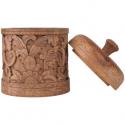 By Roy Butler
By Roy Butler
The inhabitants of early Fredericksburg enjoyed a cool drink during the hot summer months, just as we do today - hence the massive excavations referred to as ice houses. These brick-lined, wood-floored structures were generally 15 to 20 feet in depth and 12 to 15 feet in diameter.
Dairy products, meats, and other perishables had to be kept cool, and what better way to do it than to cut the ice from the Rappahannock or a local pond during January, store it in a circular, subterranean cavity, cover it with straw, and preserve it for the warm months ahead.
These massive ice boxes maintained an adequately cool temperature throughout the summer months. Though not as efficient and convenient as our modern refrigerators, they did the job and kept fresh butter, milk, meats, and vegetables on the table, and, of course, ice for the after dinner drink.
These structures were roofed and some sort of ladder or step arrangement was used to descend to the level of the stored ice.
Several have been located in the Fredericksburg area. Recently The Sentry Box, property of Mr. and Mrs. Charles McDaniel, cleaned out its splendid example and restored it for posterity.
Another is located on the property of Dr. and Mrs. Robert Wheeler, Princess Anne and Lewis Streets. Excavated and refilled, this one yielded hundreds of intact discards of the mid- to late-nineteenth century.
Most ice houses seem to have been filled after the Civil War when private delivery services were apparently established. They evidently were filled in quickly, as the discards top to bottom do not generally vary greatly in age.
Others are located on the National Park Service property on the river side of the 1400 block, Sophia Street. Clearview and Ferry Farm have outstanding examples. The 700 block of Caroline has a filled ice house that by now is inundated. One of the most talked about is on the 1200 block of William Street, in the heart of Civil War activity.
These grand old utilities of the eighteenth and nineteenth centuries were an important part of the lives of early Fredericksburgers. A restored ice house would make a splendid educational and tourist attraction. Perhaps the future will see this materialize.
This article was published in its original form in The Fredericksburg Times magazine and reprinted in Fredericksburg Underground, a collection of Mr. Butler's writings. It is reprinted here with Mrs. Butler's permission.


